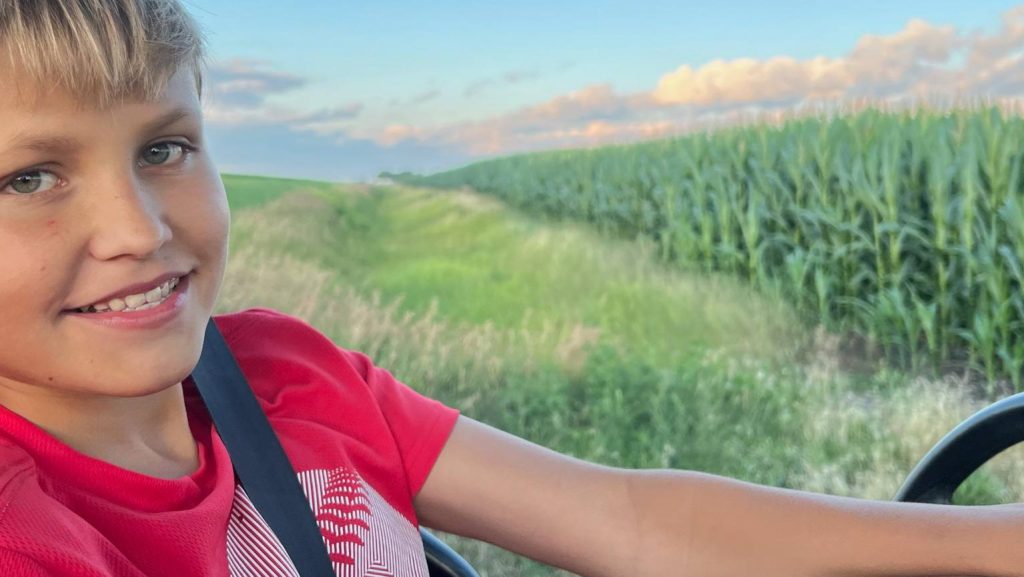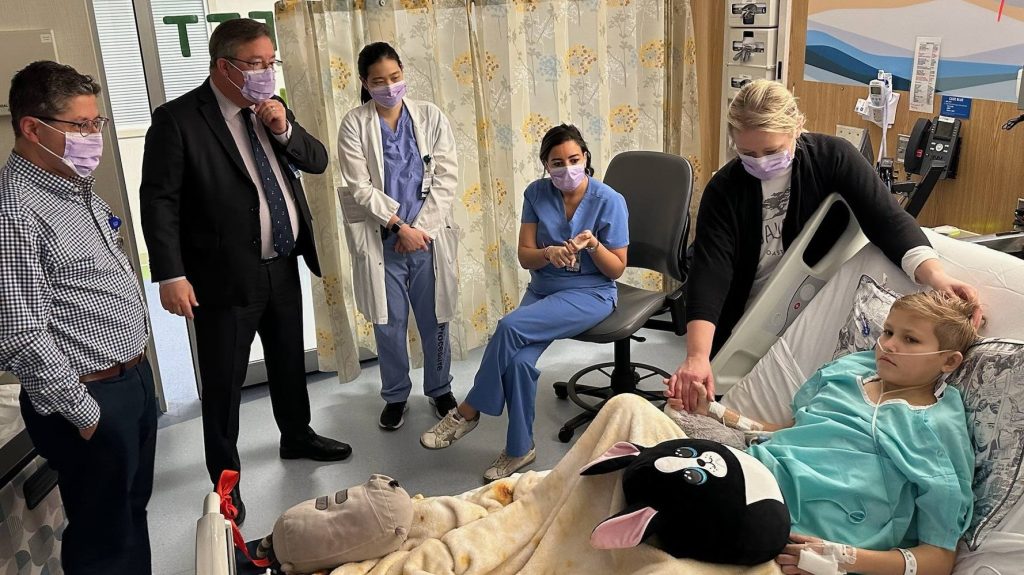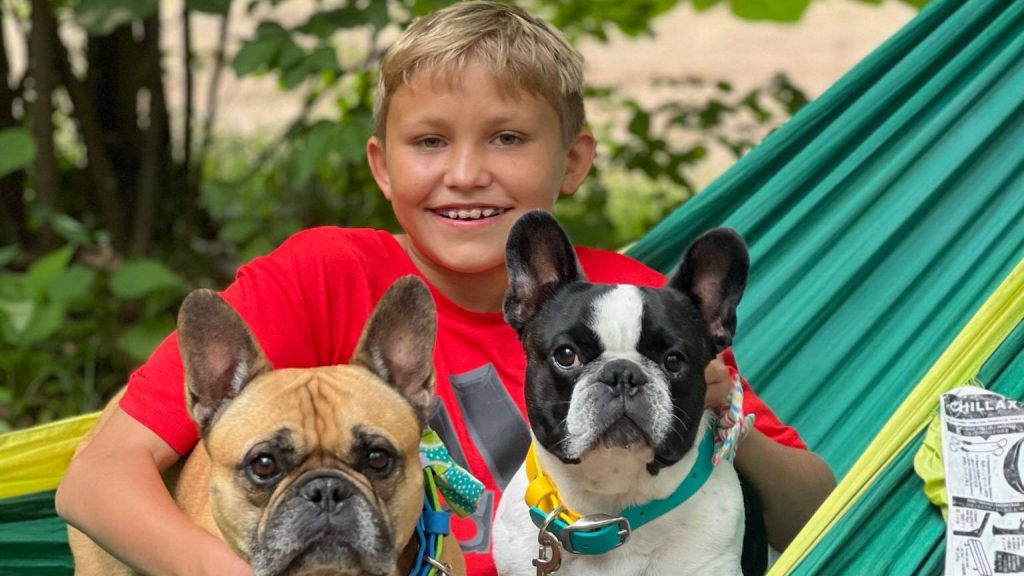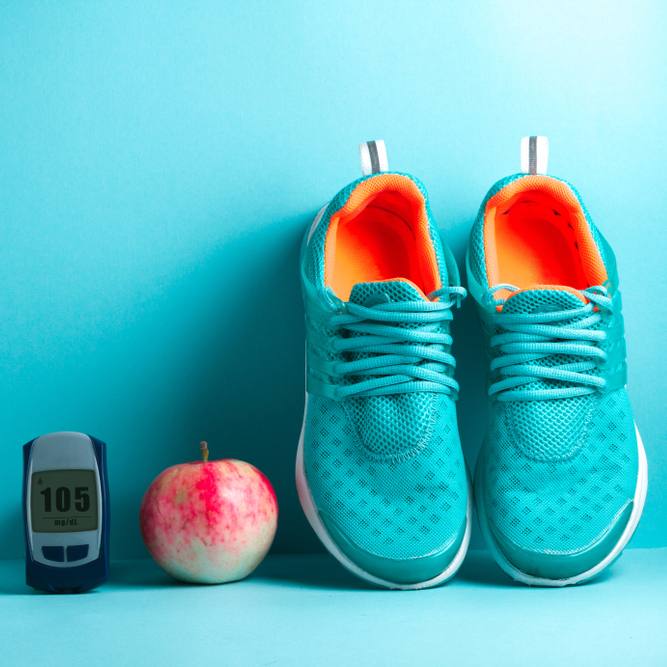-
Transplant
Beckett gets a lifesaving birthday gift

At birth, Beckett Hoggarth Beyer appeared to be a healthy newborn baby boy, growing and changing like a typical infant. But when his aunt — a physician — visited their home near Fargo, North Dakota, she noticed something was not right. Beckett's stools were light in color, and his skin tone was slightly more olive-toned than expected.
Beckett's parents, Tracie Hoggarth and Ron Beyer, took him to his pediatrician. Blood tests revealed elevated liver enzymes, which often indicate inflammation or damage to liver cells.
To find out more about the cause of Beckett's symptoms, the family traveled to Minneapolis to see a pediatric gastroenterologist. At just eight weeks of age, fearing Beckett had biliary atresia — the most common condition associated with his symptoms at this age — they pursued advanced care to investigate the cause of his liver disease.
For the next 13 years, Beckett's care was managed by a few teams of gastroenterologists in Minneapolis.
After several rounds of genetic testing, they discovered that his liver disease was caused by Alagille syndrome. This rare genetic disease affected his liver and bile ducts by reducing bile flow out of the liver and causing jaundice, which is the darkening and yellowing of the skin and the whites of the eyes. This bile buildup in the liver damages cells, eventually leading to liver failure.
Alagille syndrome can affect the liver, heart, kidneys, skeleton, eyes and blood vessels. Complications of the syndrome may be life-threatening. Fortunately, Beckett's form of Alagille syndrome only affects his liver.
Living with liver disease
Beckett is a mechanically inclined 14-year-old who likes lawn mowers, riding four-wheelers, and repairing and driving RC cars. But his liver disease was throwing a wrench in his health and keeping him from doing all the activities he enjoys.
For several years, he had a mass growing in his liver that eventually grew to 10 by 13 centimeters in size. "For three years, they monitored it via ultrasound and secondary conditions from his liver disease with endoscopy, which is how we learned his disease was advancing," recalls Tracie. “When they performed an updated biopsy on his liver, they learned he had advanced cirrhosis.” Cirrhosis is severe scarring of the liver, which makes it difficult for the liver to do its job.
Given a liver transplant was becoming a likely future necessity, Beckett’s family wanted the best for their son — so they sought the medical expertise of Mayo Clinic.
In November 2023, Beckett had an initial consultation and testing at Mayo Clinic in Rochester, Minnesota. The care team at Mayo Clinic recommended that Beckett be put on the liver transplant list before he became more ill.
With stage 4 liver cirrhosis and a tremendously enlarged spleen, Beckett dealt with difficulty breathing due to his firm liver pressing against his diaphragm. Not only did he have a distended belly and chronic back pain from his liver disease and his enlarged spleen, but low platelet count put him at an increased risk of bleeding.
He had a yellow cast to his skin and was in end-stage liver disease — things that had just become normal for him. But his blood tests showed he was on the cusp of crisis.
The request to put Beckett on the transplant list was approved, and he was placed on the list in mid-February. During appointments with the liver transplant team, Beckett shared, "Maybe I'll get a liver by my birthday."
His birthday on April 1 was quickly approaching, and getting a liver often takes months, so getting his birthday wish seemed unlikely.
The call that changed everything
Eleven days after Beckett officially went on the transplant list, Ron received a call from a Minnesota phone number.
"It'd only been a couple of weeks since we were in Rochester, and I thought maybe Mayo Clinic needed more information or was calling about another test," recalls Ron.
But the care team had something else in mind — a liver for Beckett.
The family had eight hours to get from North Dakota to Mayo Clinic in Rochester. Ron called Tracie home from work. He called the school to let them know a liver was available for Beckett and to send Beckett and his sister home immediately.
When the call came in, Beckett was in history class. "The teacher was about to start teaching, but then they said, 'Beckett, you can head to the office.' And I'm like, what for? I didn't think I was in trouble," Beckett says.
Rather than being in trouble, Beckett soon learned that he was in luck.

Out with the old, in with the new
Dr. Timucin Taner, a transplant surgeon at Mayo Clinic, performed Beckett's transplant on March 13 — just two weeks before his birthday.
"The only treatment for patients with cirrhosis is a liver transplant. Cirrhosis is a chronic disease that does not get better with other treatments," notes Dr. Taner. "Beckett needed a new liver, without any doubt. Without a transplant, Beckett would have continued to have jaundice, and his fatigue and other symptoms would have continued to get worse."
“I remember it vividly,” Tracie says. “I was astonished and grateful for the surgeon. Dr. Taner even took the time to wheel Beckett in his hospital bed down to the surgical suite.”
After hours of tenuous waiting, the transplant was a success. The transformation was noticeable. The night before the transplant, Beckett's eyes were yellow-tinted, but the morning after the transplant, they were already white, recalls Tracie.
Beckett recovered in the pediatric intensive care unit at Mayo Clinic for the next 10 days.
"I got the power-reclining bed with the remote and all the warm sheets I needed," says Beckett.
Visits from a Caring Equine miniature pony named Munchkin and a pet therapy dog named Benny Burrito were highlights of his stay.
"He was kind of sad to get discharged. He was getting like a five-star hotel experience," laughs Tracie. "It says volumes about the care they got when somebody is sad to get discharged."
Beckett and his parents note that all the staff they encountered were exceptionally kind and professional. The entire team — the pediatric intensive care unit doctors, his gastroenterologists, the nurses and the support staff — cared about Beckett and his journey.

Loving his new liver
Since getting the transplant, Beckett can go on long walks. He has more energy, can breathe much better and has less back pain.
"I would get winded just walking, and I couldn't play football or participate in contact sports," says Beckett when thinking back to life before his transplant. "I felt stuffy after I drank or ate a lot. And then when I had my transplant, it felt like I had a lot more space."
Beckett's medication regimen has significantly improved. Previously, he endured a challenging schedule with many daily pills, a bitter-tasting oral medication and daily self-administered injections. Now, he takes a set of pills in the morning and early evening.
Dr. Samar Ibrahim, a pediatric transplant hepatologist at Mayo Clinic, manages Beckett's ongoing care. Dr. Ibrahim routinely monitors Beckett's medication regimen and watches for signs of rejection or infection in his lab work.
"Beckett's new liver is functioning normally, so his symptoms of end-stage liver disease are gone," says Dr. Ibrahim. "He will get to live his life like any other teen and celebrate many more birthdays."
For Beckett and his family, receiving a new liver was the best birthday gift they could have imagined. "When he got the liver before his birthday, we were astonished," says Tracie. "We will be eternally grateful for that."







